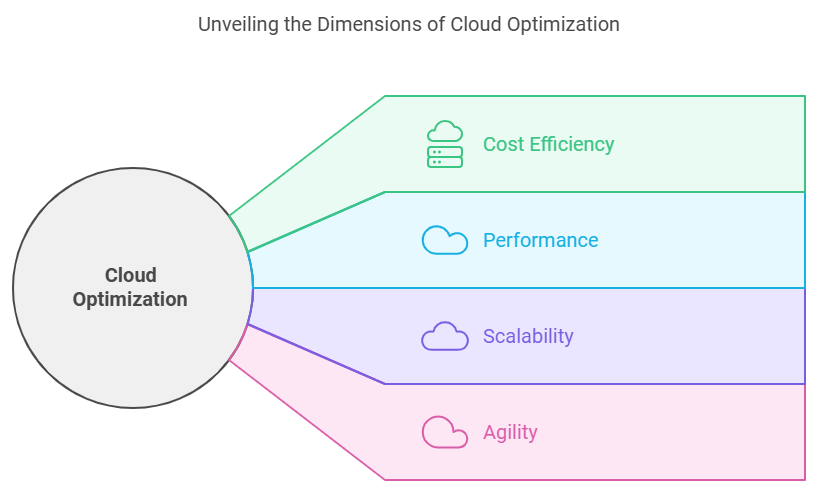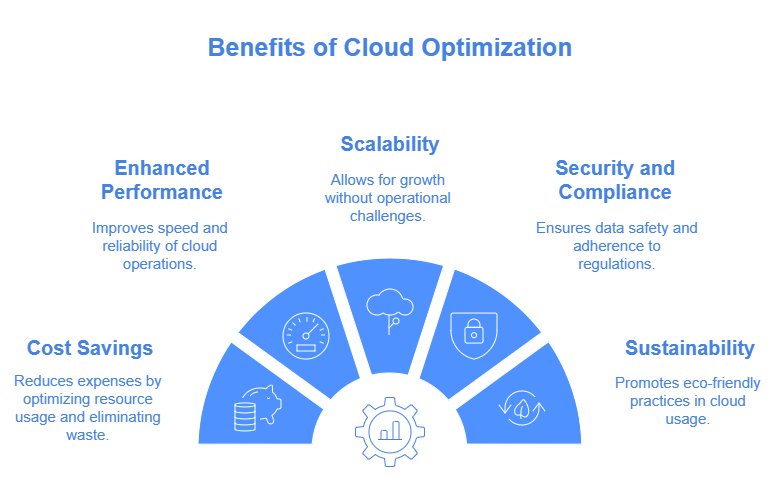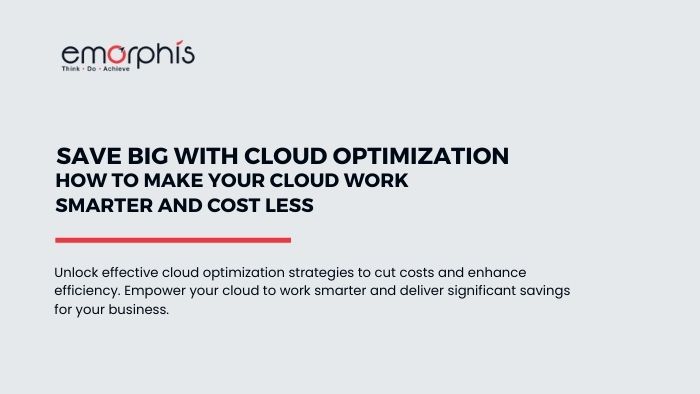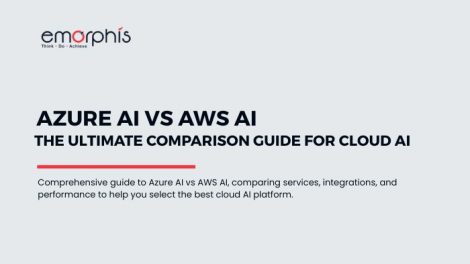In today’s fast-paced digital world, businesses are relying more and more on cloud services to scale their operations and store data. However, without proper cloud optimization, companies may end up overpaying for resources that aren’t being fully utilized. Whether you’re managing a large enterprise or a small startup, cloud optimization can unlock significant cost savings while improving the overall performance of your cloud infrastructure.

In today’s tech-driven world, cloud computing has become indispensable, with the global market poised to reach $1.24 trillion by 2027, growing at a CAGR of 17.9% a report by Cloudwards. Businesses increasingly adopt hybrid and multi-cloud strategies, with 71% using hybrid models to blend security and scalability. Yet, as 82% of organizations struggle with managing cloud costs, optimizing cloud infrastructure has never been more critical. These challenges coincide with the rise of AI-driven cloud integration. Moreover, with sustainability also emerging as a priority. Effective cloud optimization strategies are essential to balance performance, costs, and environmental goals.
Let us now check the essentials of cloud optimization. Also explore why it’s crucial for your business, and how you can implement cloud optimization strategies. Moreover, that saves money and enhances the cloud’s efficiency.
What Is Cloud Optimization?
Cloud optimization refers to the process of maximizing the performance and cost-efficiency of your cloud infrastructure. This involves fine-tuning various aspects of your cloud environment. Which is such as computing power, storage, network bandwidth, and security. In fact, this is to ensure that you’re only paying for the resources you actually need and that they are being used efficiently.

Cloud optimization is not just about reducing costs. It’s also about improving the performance and scalability of your cloud infrastructure. Furthermore, making it more agile and responsive to the demands of your business.
Click the link to learn why safeguarding cloud data is critical. Also, identify potential threats, and implement best practices to ensure cloud data security and compliance.
Common Challenges in Cloud Optimization
Achieving optimal performance and cost savings isn’t always easy. Here are some common challenges businesses face when optimizing their cloud infrastructure:
- Overprovisioning: Many companies make the mistake of provisioning more cloud resources than they actually need, leading to unnecessary costs. This is one of the main areas where cloud optimization can help.
- Underutilized Resources: On the flip side, companies may fail to fully utilize their cloud resources. For example, leaving virtual machines running when they’re not needed or underusing storage space.
- Complexity: As your cloud infrastructure grows, managing and optimizing resources becomes more complex. Without the right tools or knowledge, optimization can be a daunting task.
- Lack of Automation: Without automated processes, cloud optimization becomes a time-consuming manual effort. Moreover, automation can help streamline the process, making it easier to maintain and adjust your cloud resources.
Explore with a click on the link to achieve a seamless balance between flexibility and security with a hybrid cloud strategy.
Steps to Optimize Your Cloud
Step 1 – Analyze Usage Patterns
The first step in cloud optimization is to understand how your cloud resources are being assigned. By analyzing usage patterns, you can also identify underutilized resources and areas where you may be over-provisioned. Moreover, this will help you make data-driven decisions about resource allocation.
Step 2 – Leverage Auto-Scaling
Auto-scaling is a key feature of cloud optimization that allows you to automatically adjust your resources based on demand. Also, with auto-scaling, you can ensure that you’re only using what you need. Moreover, you can avoid wasting money on idle resources during off-peak times.
Step 3 – Right-Size Your Resources
Right-sizing involves selecting the appropriate cloud instances based on your actual needs. Instead of opting for larger, more expensive instances, consider choosing smaller ones that can handle your current load without overprovisioning.
Step 4 – Implement Cloud Cost Management Tools
Cloud cost management tools are to track your spending, identify inefficiencies, and provide recommendations for cloud optimization. Tools like AWS Cost Explorer, Azure Cost Management, and Google Cloud Cost Management. Further, can give you visibility into your cloud expenses and help you identify areas for improvement.

Step 5 – Monitor and Adjust Regularly
Cloud optimization is not a one-time task; it’s an ongoing process. You should regularly monitor your cloud resources and adjust them based on changing business needs and usage patterns. By staying proactive, you can continuously improve your cloud performance and reduce costs.
Step 6 – Use Reserved Instances
Many cloud providers offer discounted rates for reserved instances. Further, it allows you to commit to a certain level of usage for a fixed period. If you can predict your cloud usage, reserved instances can be an effective way to reduce costs and optimize your cloud.
Uncover ten transformative trends revolutionizing cloud application development and reshaping how businesses innovate.
Tools for Cloud Optimization
There are several tools available that can assist you in the cloud optimization process:
- AWS Trusted Advisor: This tool analyzes your AWS environment and provides recommendations for improving performance, security, and cost-efficiency.
- CloudHealth by VMware: CloudHealth helps businesses monitor and optimize their cloud spending by providing detailed analytics and actionable insights.
- CloudCheckr: CloudCheckr is a cloud optimization platform that offers a suite of tools for managing and optimizing costs across multiple cloud providers.
- Kubecost: If you’re using Kubernetes, Kubecost provides real-time cost monitoring and optimization for Kubernetes clusters, allowing you to manage and optimize your cloud spend.
The Benefits of Cloud Optimization: A Deeper Dive
The real power of cloud optimization lies in the tangible benefits it can bring to your organization. Let’s expand on how cloud optimization can positively impact various areas of your business:
1. Cost Savings: The Bottom Line Boost
By reducing unused or underutilized resources, cloud optimization allows businesses to significantly lower their cloud-related expenses. Companies can reduce their cloud costs by:
- Eliminating idle resources: Services such as virtual machines or storage can be automatically turned off or reduced during non-peak hours, saving costs without impacting business operations.
- Choosing the right pricing models: With cloud optimization, you can take advantage of pay-as-you-go models, spot instances, reserved instances, and auto-scaling to match your precise resource needs, all of which contribute to more cost-efficient operations.
- Paying for what you use: By fine-tuning your cloud environment, you can ensure that your resources match your exact needs, thus avoiding paying for excess capacity.
2. Enhanced Performance: Faster and More Reliable Operations
Cloud optimization is not just about saving money; it’s also about making your cloud infrastructure more effective. Optimized cloud environments run faster and are more resilient, providing the following benefits:
- Improved response times: By configuring resources based on performance needs, businesses can minimize latency and ensure that applications are running at optimal speeds.
- Better load balancing: With optimized configurations, traffic can be routed efficiently across the cloud to prevent performance bottlenecks, ensuring that all systems run smoothly even under heavy demand.
- Preventing downtime: Performance-related issues like slow load times or unresponsive applications can be prevented by cloud optimization, which ensures that resource allocation meets the requirements of your business needs.
Explore the types, advantages, and step-by-step process of cloud migration services, designed to optimize business operations in the cloud.
3. Scalability: Growth Without the Growing Pains
One of the standout features of cloud optimization is the ability to scale resources up or down seamlessly. This means that businesses can grow quickly while ensuring that their cloud infrastructure remains cost-efficient.
- Dynamic scaling: Cloud optimization uses automated scaling tools that adjust resources as demand increases or decreases, ensuring that businesses aren’t left over-provisioning when demand is low or scrambling when demand spikes.
- Meeting fluctuating demand: Whether it’s a sudden increase in traffic or seasonal demand spikes, cloud optimization ensures that resources are automatically scaled to accommodate fluctuations in usage without overspending.
- Efficient resource allocation: By dynamically allocating resources only when needed, businesses can scale more efficiently, without the risk of underprovisioning or overpaying.

4. Security and Compliance: A Cloud That’s Safe and Sound
Cloud optimization also extends to ensuring your cloud infrastructure remains secure and compliant. This can include fine-tuning your security configurations, auditing resources, and ensuring that you’re not paying for extra security layers you don’t need.
- Streamlined compliance: For businesses in regulated industries, cloud optimization ensures that your cloud environment meets the compliance requirements of GDPR, HIPAA, or other industry standards, without overburdening your infrastructure.
- Proactive threat management: With optimized security protocols, businesses can stay ahead of potential threats without the need for excessive security spending.
- More efficient resource access: By minimizing unnecessary access points and optimizing firewalls, businesses can reduce security risks and improve data protection while saving on unnecessary overhead.
5. Sustainability: A Greener Cloud
With growing concerns about environmental impact, cloud optimization can also contribute to sustainability. By ensuring that cloud resources are only used when necessary, businesses can reduce their carbon footprint.
- Lower energy consumption: Optimized cloud environments require less energy to run, which leads to both financial savings and a reduced environmental impact.
- Greener resource allocation: Automated processes ensure that resources are being allocated efficiently, avoiding wastefulness, and helping companies meet their sustainability goals.
Save Big with Cloud Optimization
When businesses properly leverage cloud optimization, they can see immediate and long-term financial benefits. Here’s how you can save big:
- Identify Unused or Idle Resources: Unused resources that are left running unnecessarily are a quick way to rack up costs. By eliminating or downsizing these, companies can start saving money right away.
- Leverage Reserved and Spot Instances: Instead of paying the premium price for on-demand resources, switching to reserved instances or spot instances can save up to 75% in some cases. This is one of the easiest ways to reduce cloud costs through cloud optimization.
- Automate Scaling: Set up auto-scaling for your cloud environment to ensure you’re only paying for the resources you need at any given time. This keeps your operations agile and cost-effective, particularly during periods of fluctuating demand.
- Right-Size Resources: Choosing the right size for your virtual machines, storage, and network resources can make a massive difference in cost. By carefully assessing your requirements, you can downsize oversized instances without compromising performance.
- Consolidate and Centralize Your Resources: Centralized resource management allows for easier monitoring and cost control. By consolidating resources and reducing fragmentation, you can ensure you’re not wasting money on unnecessary redundancy.
Dive into an in-depth analysis of AWS vs. Azure vs. Google Cloud Platform, comparing their features, strengths, and ideal use cases.
Conclusion: Start Your Cloud Optimization Journey Today
Cloud optimization is a crucial step in making your cloud environment more efficient and cost-effective. By understanding your resource usage, leveraging automation, and implementing best practices, you can significantly reduce your cloud expenses and improve the performance of your infrastructure.
Connect with the cloud computing experts at Emorphis Technologies to unlock the full potential of your cloud infrastructure. Our team specializes in cloud optimization, tailored solutions, and seamless integration across platforms to help you achieve high performance, security, and cost efficiency.

Whether you’re aiming to scale your operations, enhance data security, or reduce cloud expenses, our experts offer customized strategies to transform your cloud into a robust, agile environment that meets your unique business needs. Embrace smarter cloud solutions with Emorphis Technologies and elevate your digital capabilities to the next level.
Don’t wait for the cloud bill to hit you hard—start optimizing today and unlock the potential of a smarter, more efficient cloud that saves you money while driving better performance.






 Must-Know Software and App Development Tips for the Modern Business
Must-Know Software and App Development Tips for the Modern Business